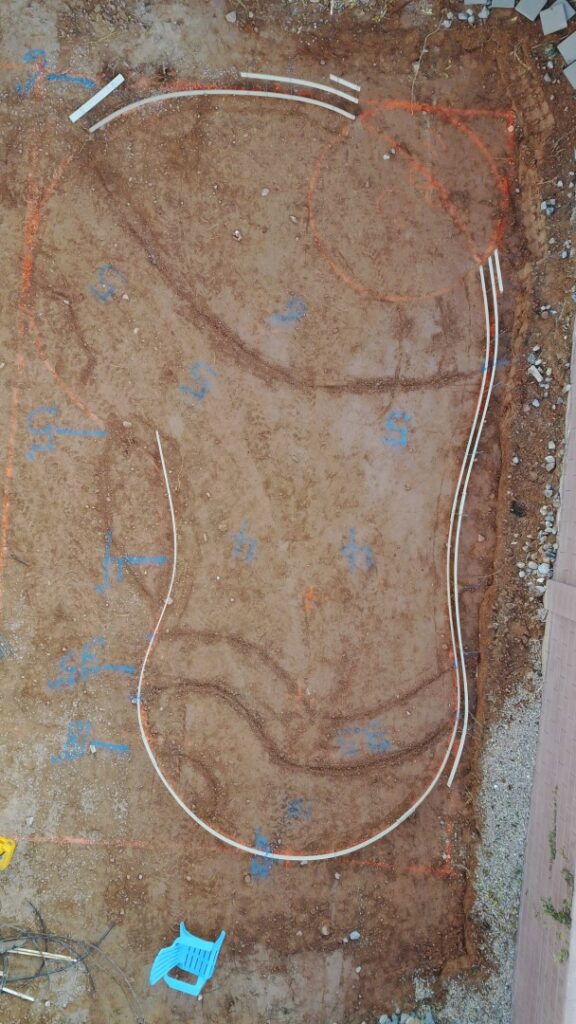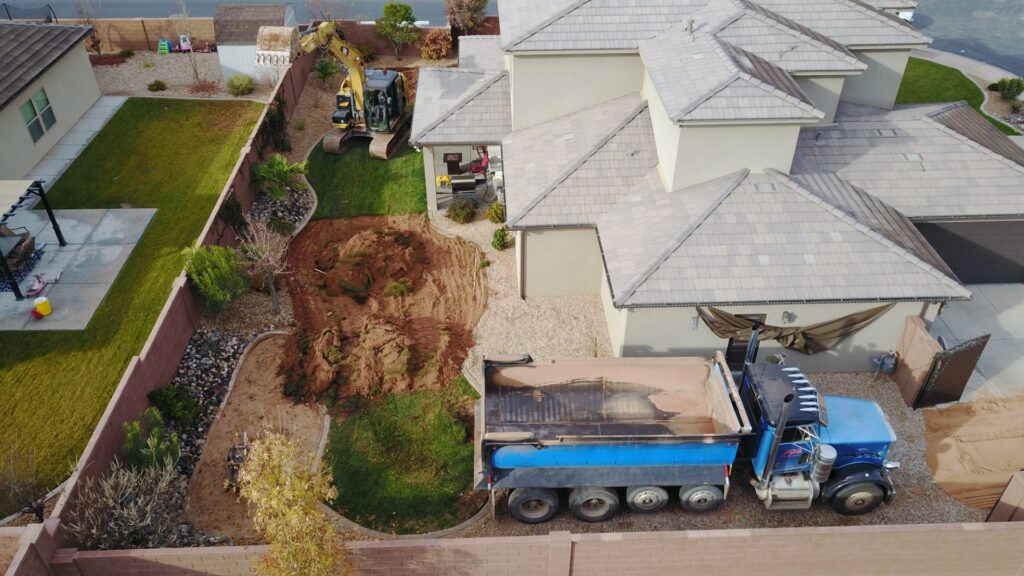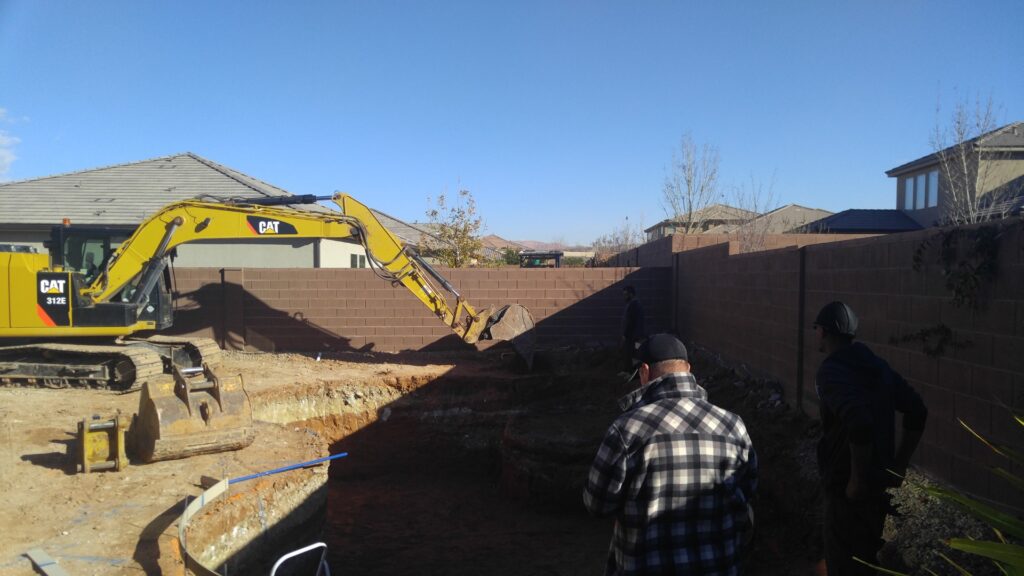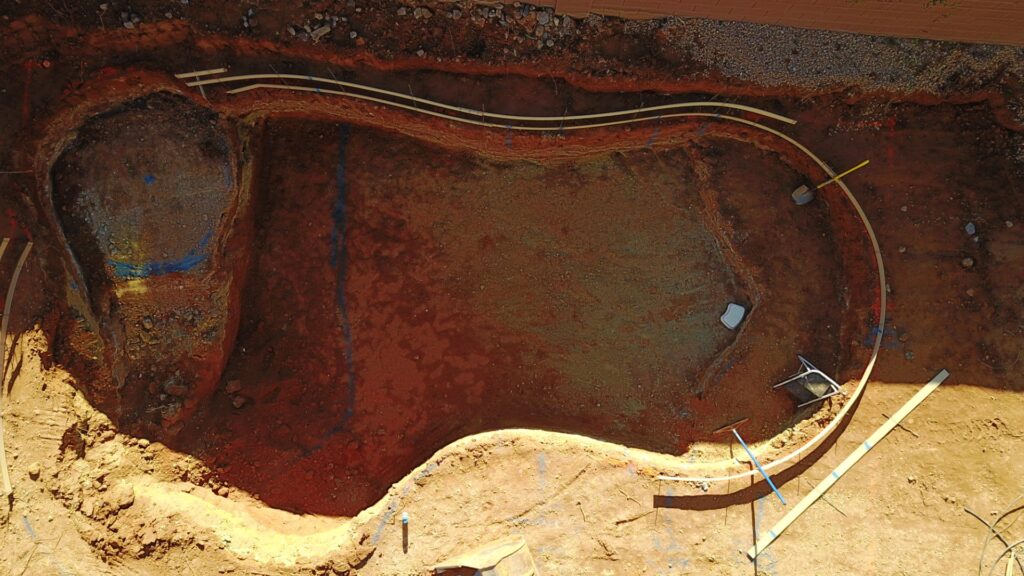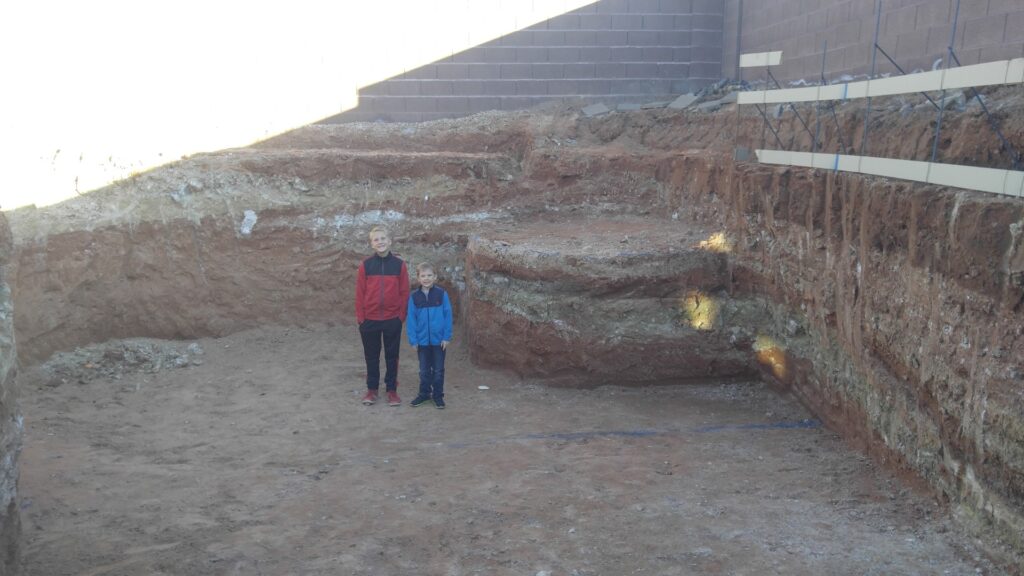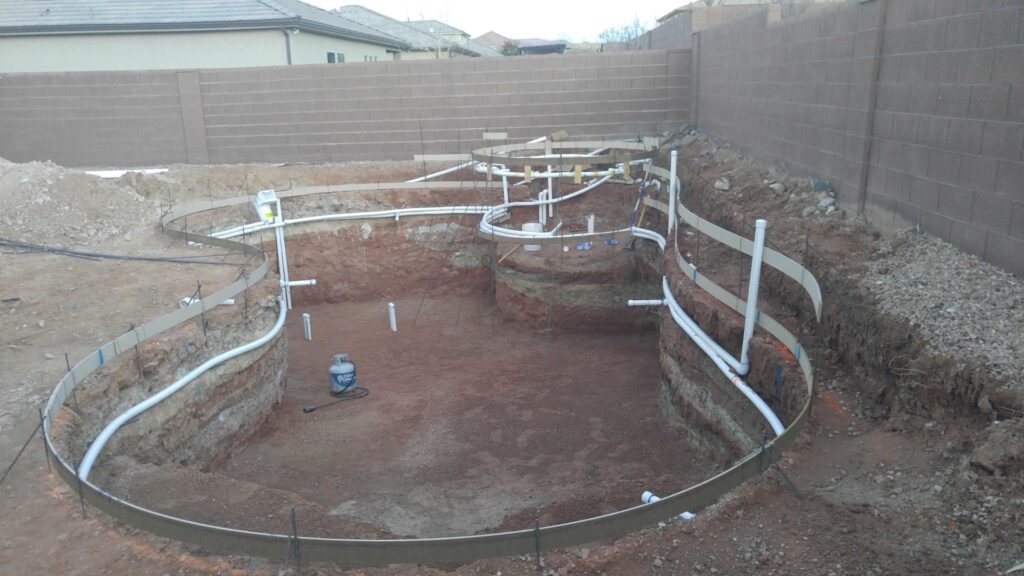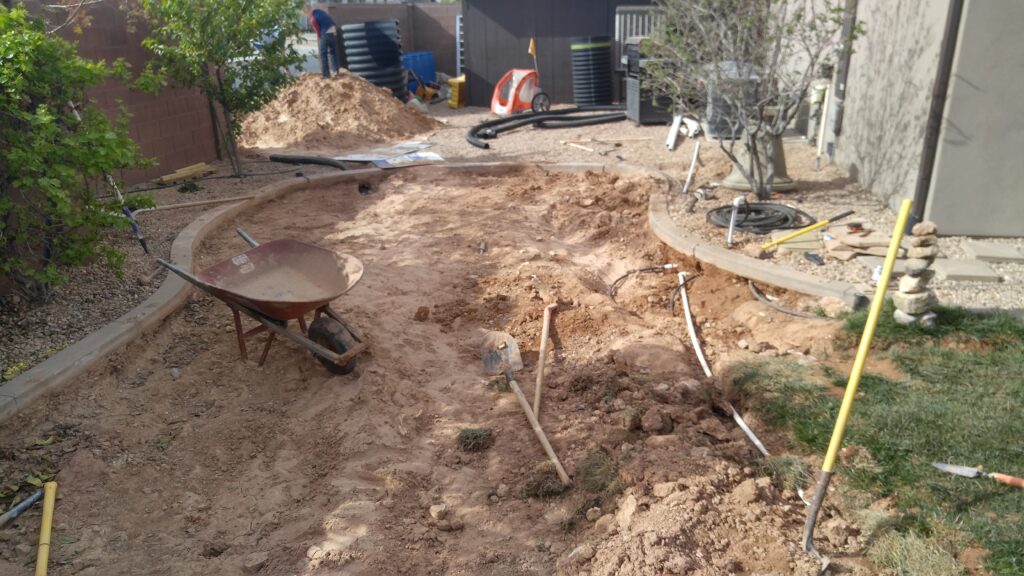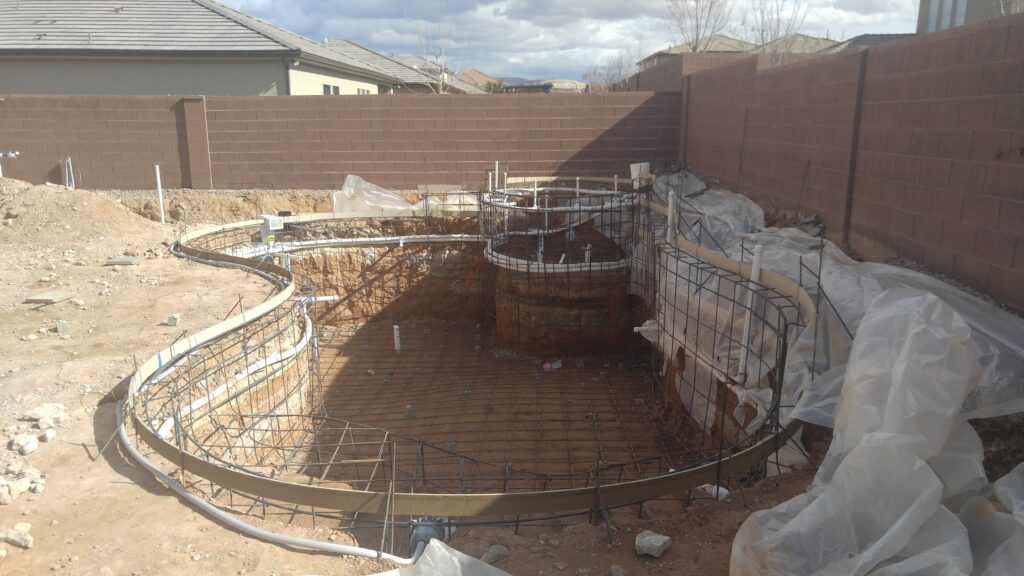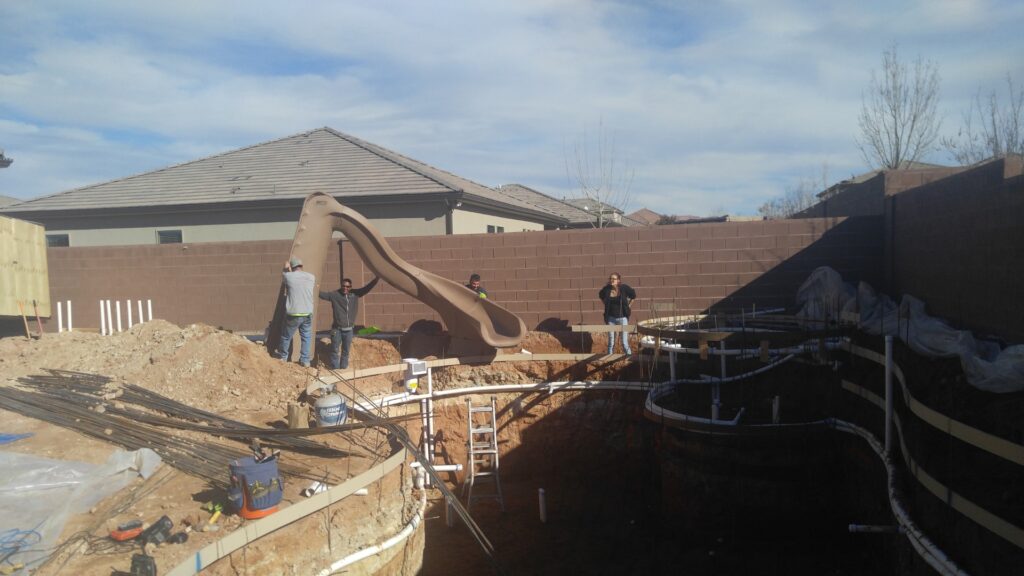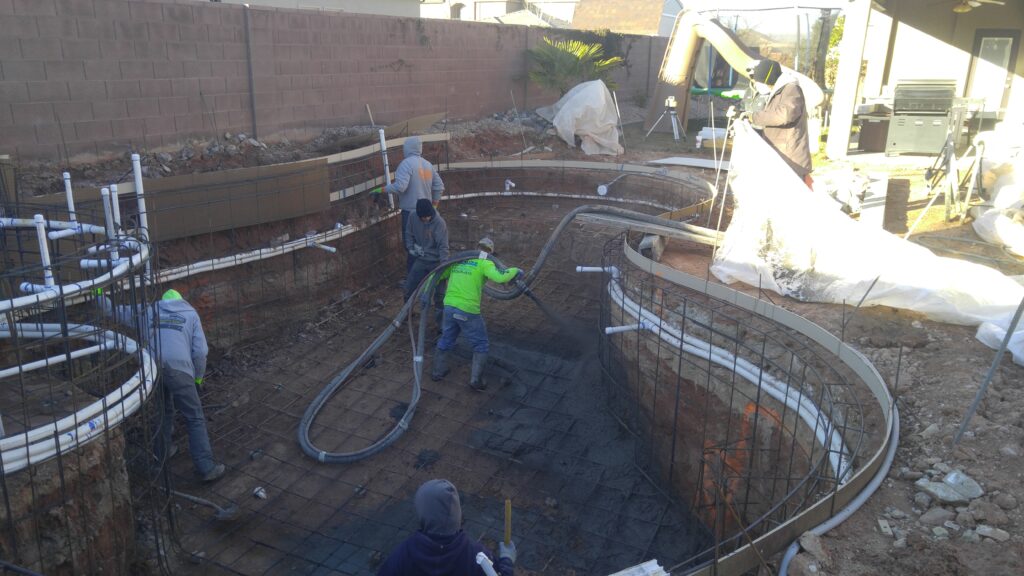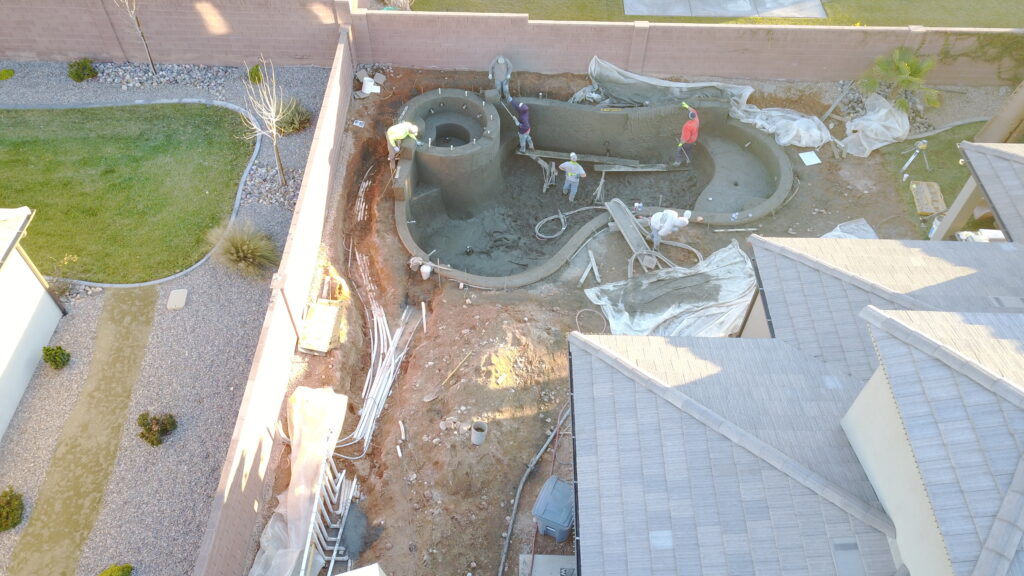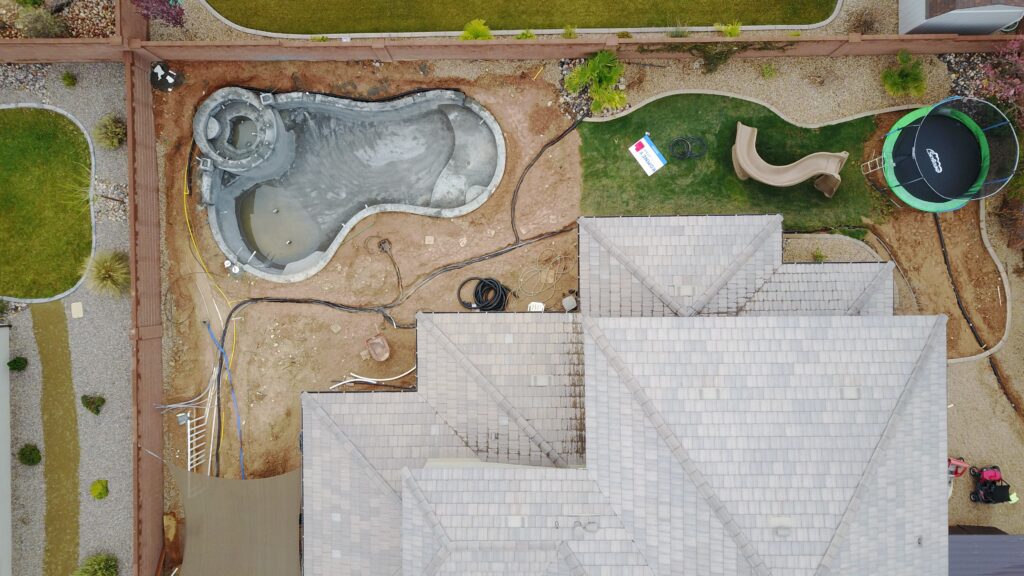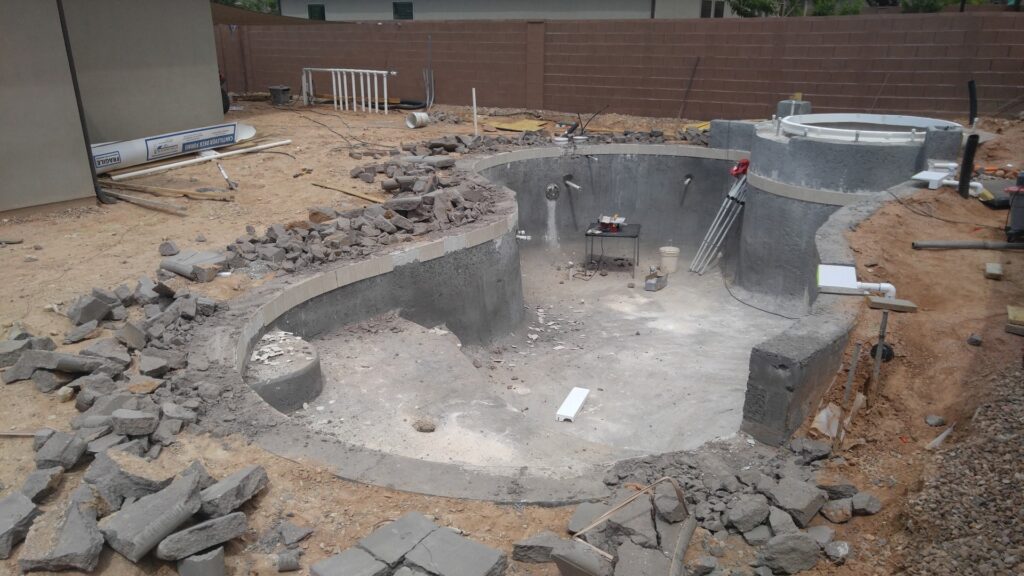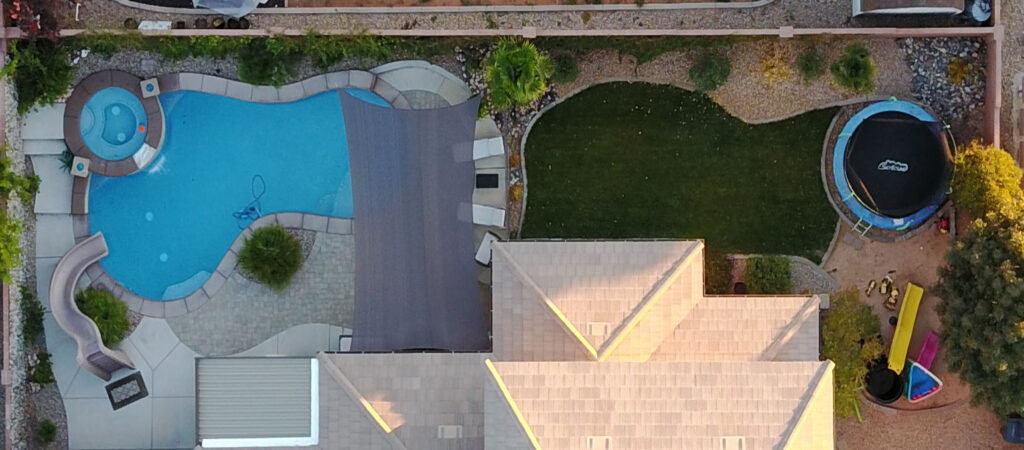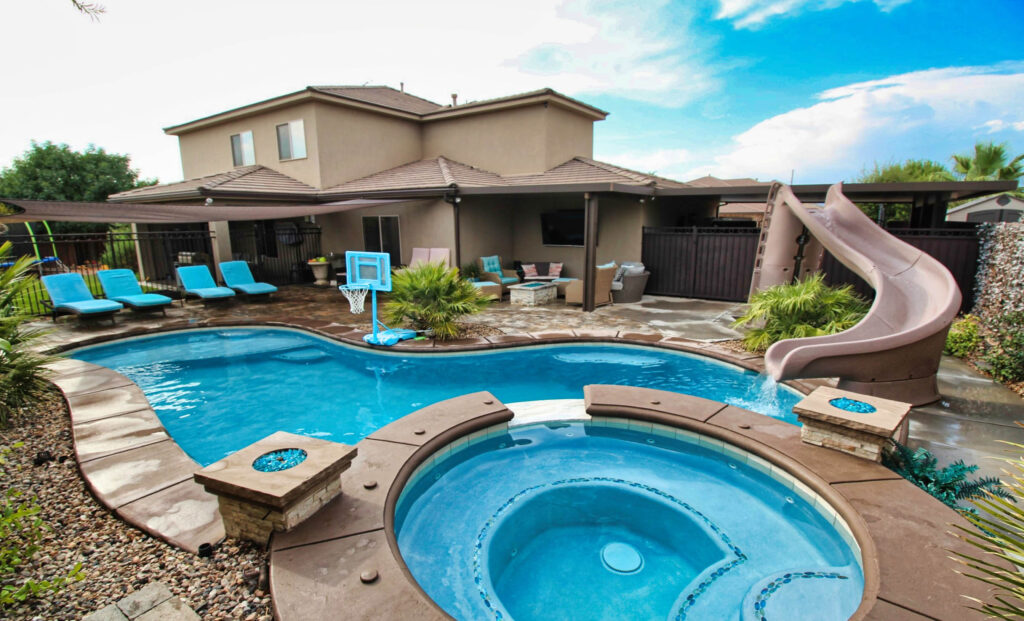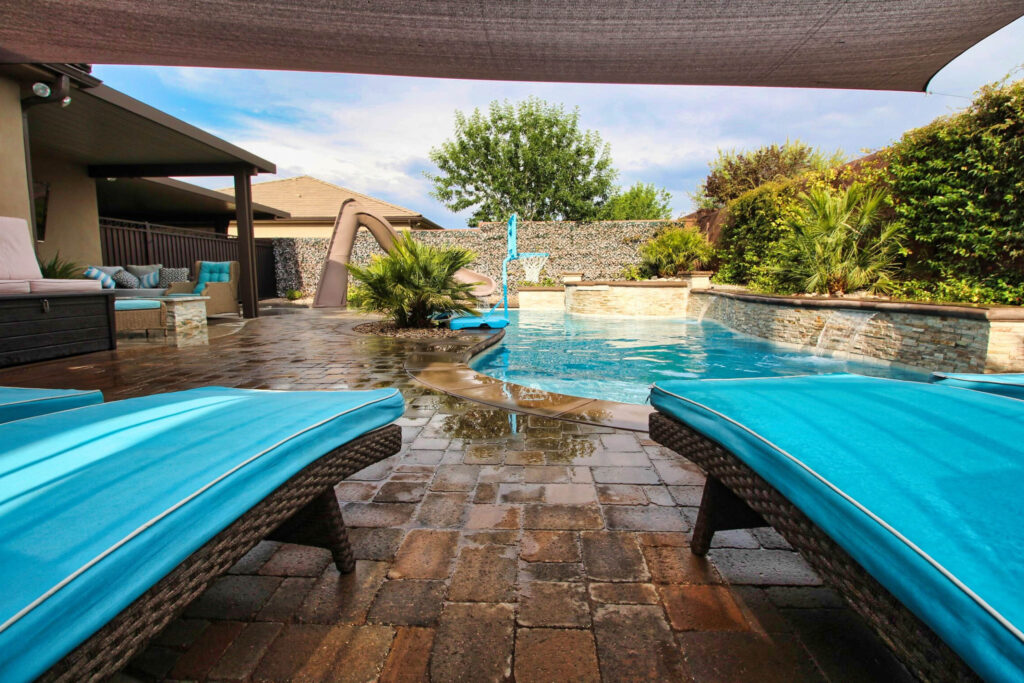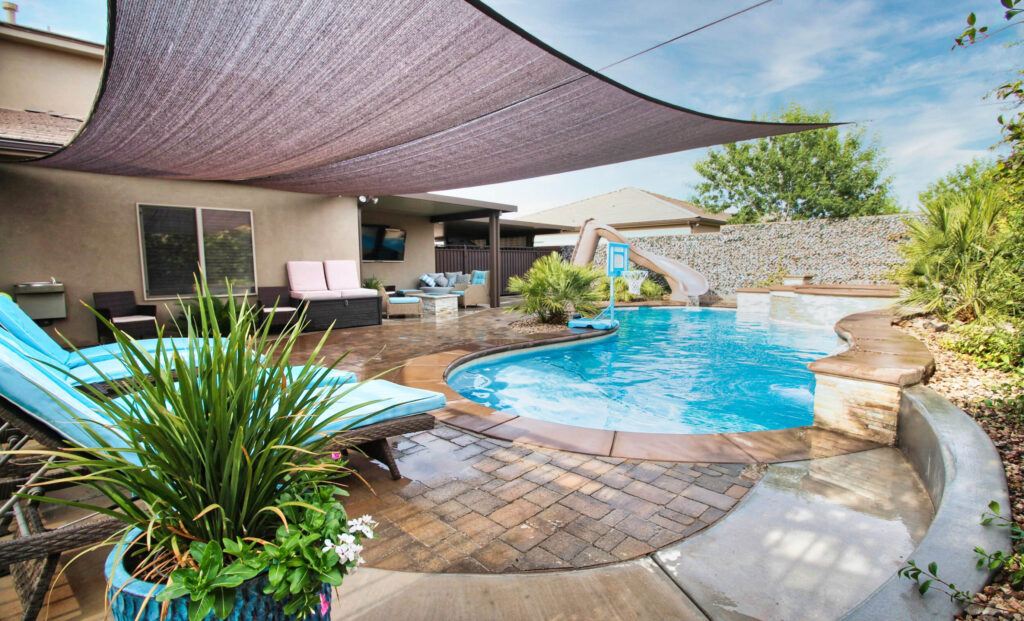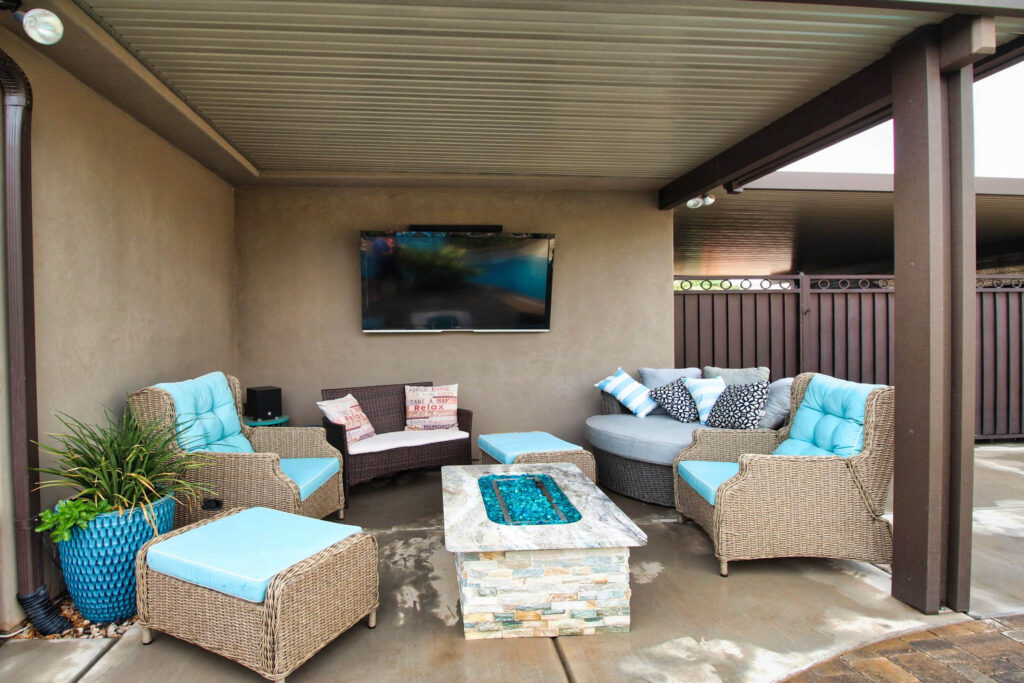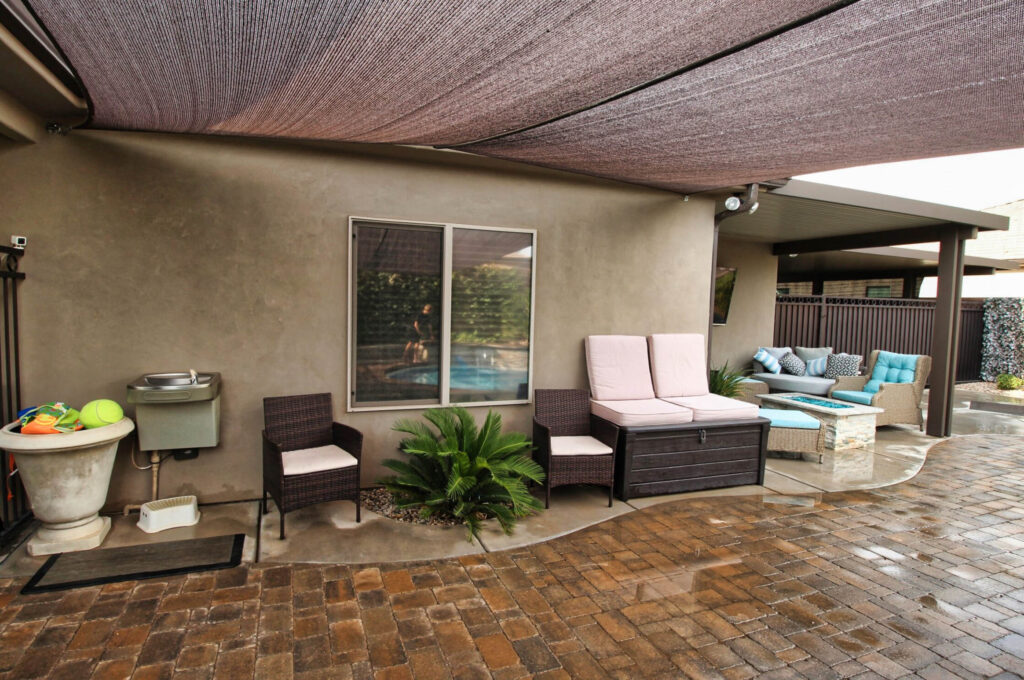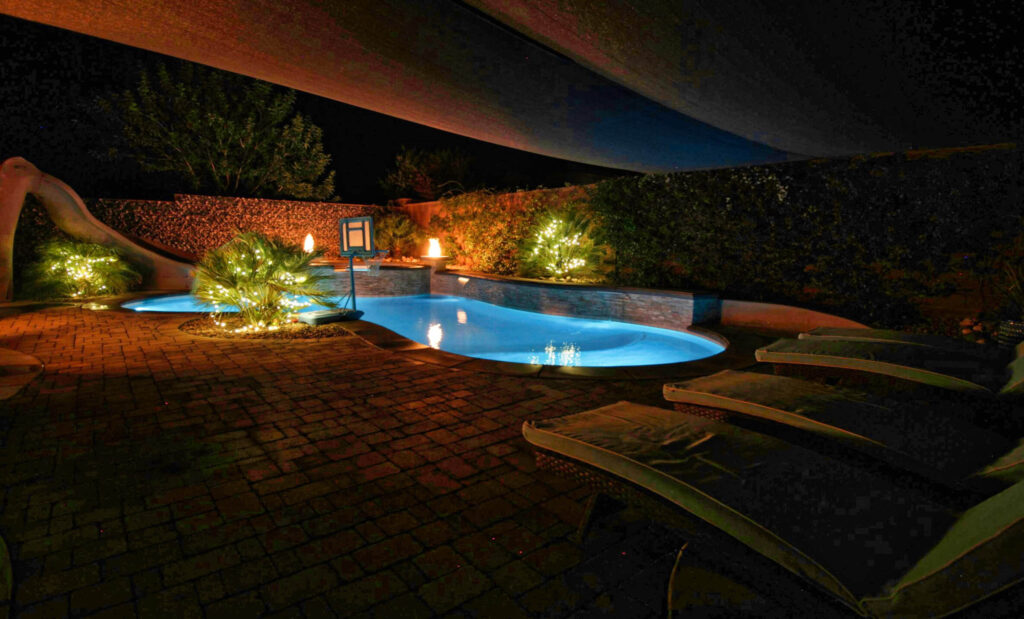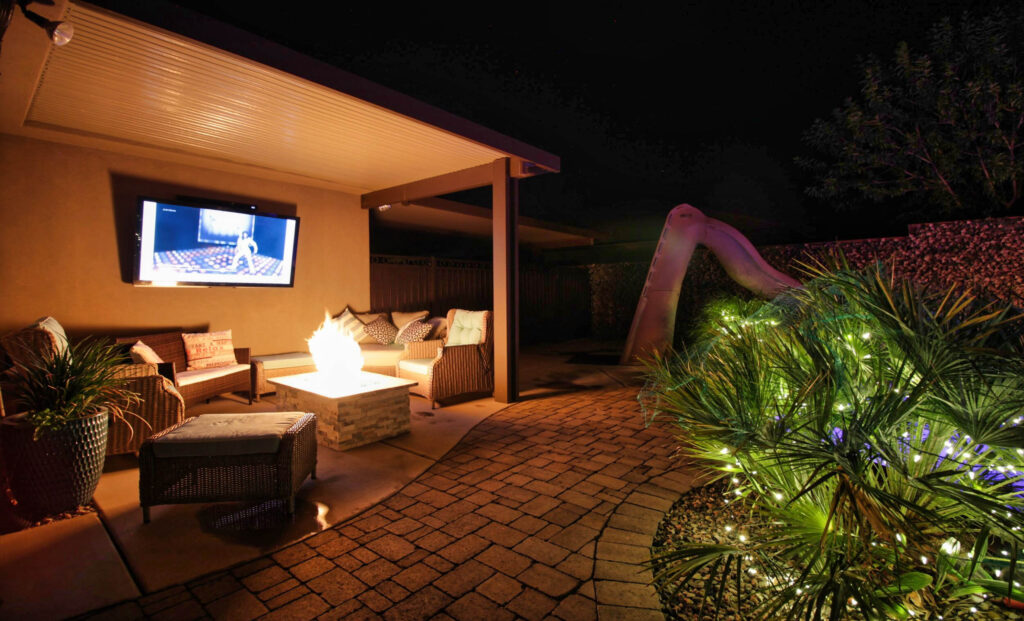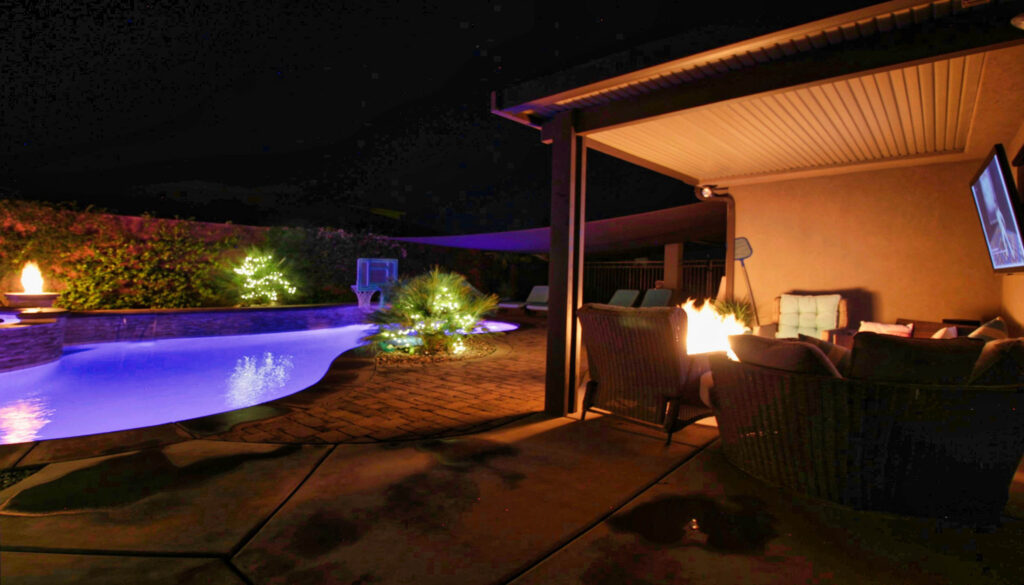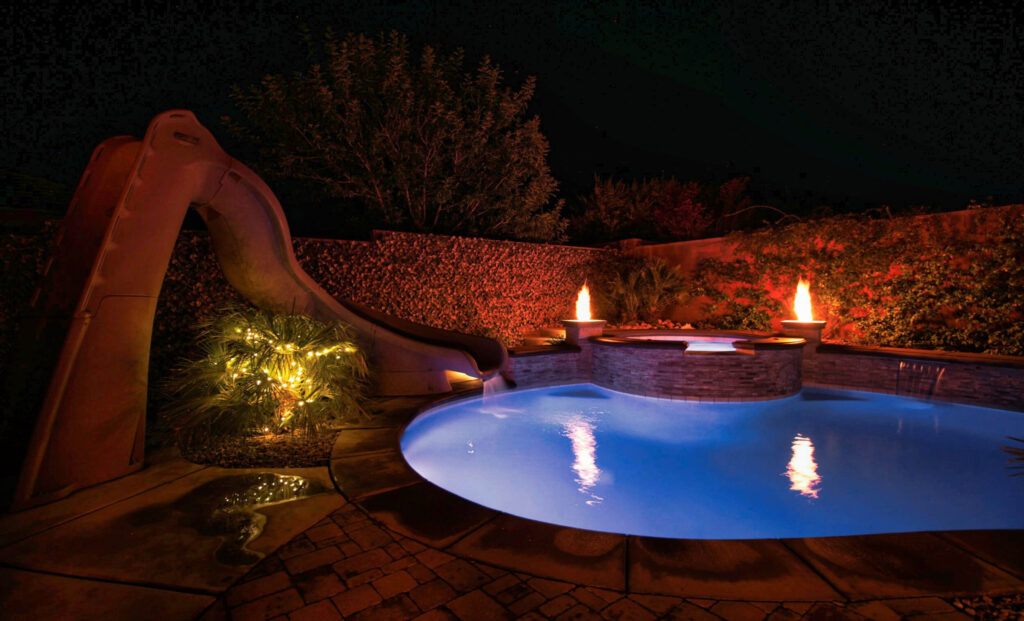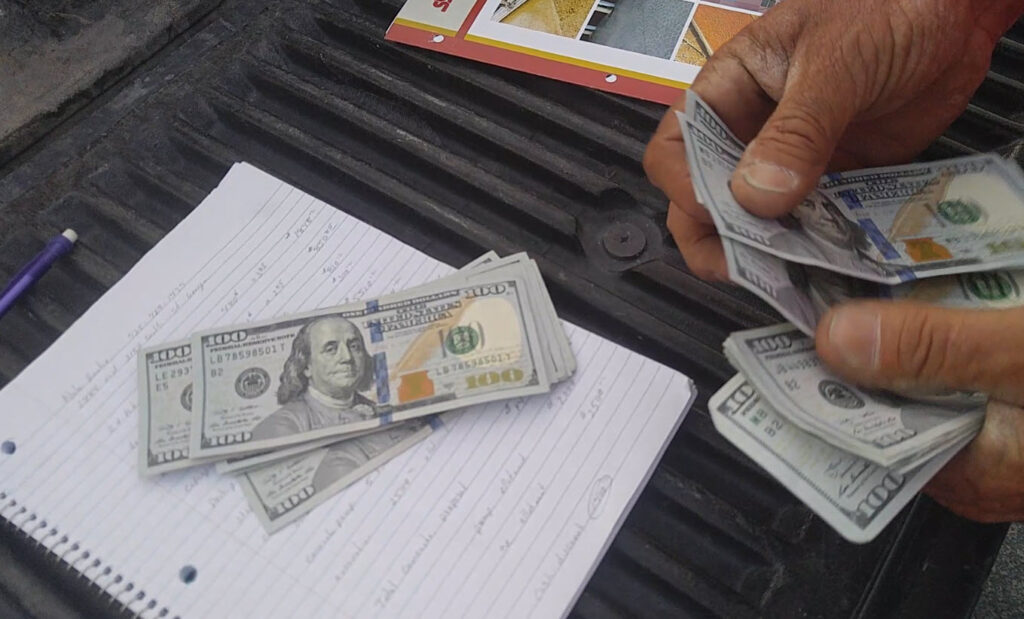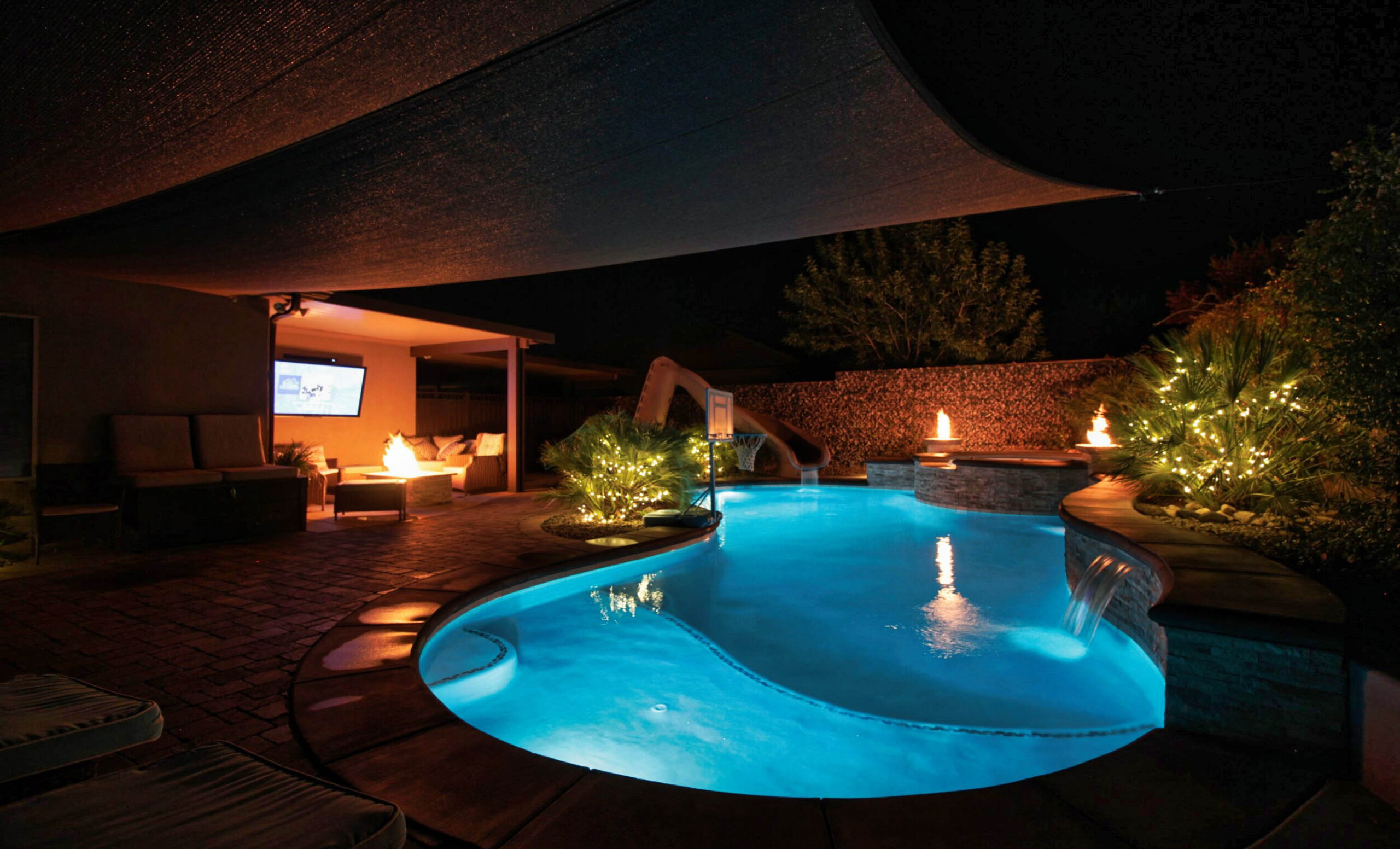SO, YOU WANT TO BUILD A POOL
Some would argue that anyone who puts in a pool is a dummy. I disagree, but I think that a fair number of people who put them in might not be making the best investment. Since putting in a pool, I’ve had a lot of people ask about the process and I’ve long wanted to do a thorough write-up on it but knew it wouldn’t be short and it took a long time to finish…… just like the process of putting in our pool : )
We put our pool in as an “owner-builder”. That means I was extremely cheap and pulled the permit, did the design, cobbled together the subcontractors myself, did a lot of work myself and bought all the equipment piece by piece and managed everything personally. In short, it was still extremely expensive and it was a MASSIVE nightmare that dragged on for nearly a year with a three month stall in the middle and many misadventures.
Longer version: We had MANY different contractors involved which I worked alongside in many cases. Many were very good and professional. One, I’m pretty sure was high as a kite most days. I preferred him on those days because he really got stuff done fast. Other days he dragged butt like you wouldn’t believe. It was a strange situation. Several contractors did shoddy work which I had to tear out myself, load in my trailer over several trips and hauled to the dump where I had to pay just to get rid of it (concrete) and then start over. Several contractors took the deposit and didn’t finish. If they got a more lucrative job than mine they just bailed out and were never seen again. Sometimes this benefitted us because they were almost done and didn’t collect the last half of the payment. Other times they left well before they were half-way done with the 50% deposit. Mostly, it was just a giant pain in the butt when contractors didn’t deliver even though financially it actually evened out.
Building a pool is easily in the top five worst experiences of my life. Yes, first world problems, but when your backyard is destroyed for nearly a year and you have young kids who want to play outside but can’t because of the dirty death pit and you’re spending money by the thousands and have only a disaster area to show for it and no end in sight, it’s a little traumatic when you’re in the middle of it. Originally we were hoping it would take about three months to complete the pool building process, and truth be told, if we were willing to pay a lot more to a professional pool builder, maybe it would have. Then again, maybe we would have put down a massive deposit for the whole project and gotten stiffed and then ended up chasing them down in court. We had heard multiple stories online of those who had ended up in that situation locally and it was truly frightening to trust a company with tens of thousands of dollars up-front. In the end I felt better about the lower cost and the fact that I was risking much less money at a time. There are many things which can make the process drag on. A lot of the steps are weather and/or sequence dependent, meaning that if one step isn’t done, it will hold everything up or if it rains hard it destroys work that was already done without special care and expertise. Likewise, extremely hot weather can be bad for concrete curing, particularly if it is stained a dark color. Obviously we wanted to enjoy our new pool during the summer, but the summer came and went and all we had in place of our once nice, grassy yard was a gigantic, sad, expensive mess.
INITIAL COST AND TIMELINE
Beyond the mess and hassle, there is the price. It should be noted that when pool builders quote a price, it is always way lower than the “real” price. The price for a pool at the 35-65K quotes we were getting would usually only get you a pool. Now, I can hear you saying “of course it only covers a pool, what did you expect”. Anyone could be forgiven for thinking that, but trust me, you don’t just want a pool. No one does. You want a lot more than that and probably just don’t realize it. Those pool quotes usually included limited or no deck, the most basic, ugly coping (edge), no landscaping, no heater, one pump (we have three), no hot tub, no lighting or basic lighting, basic white plaster, no modifications etc. You get a hole in the ground with water in it surrounded by dirt for the most basic quote. When you get what you actually envision, namely a whole backyard package which looks good, the price basically doubles or even triples with added features and stuff you’re going to want or need to do while everything is torn up anyway. When you look at an average pool there are so very many things that you never considered that are part of that package.
We started our pool in December of 2018 and I’ve detailed the prices of most of the things involved although I’m sure many hundreds or even thousands of dollars probably weren’t accounted for. There was a lot going on and many things were paid for with cash on the spot. Spoiler alert: It was about 90K. Now, that was about six years ago (at time of writing on 7/12/24). I think we all know what prices have done since then. I expect that it would be at least 30-40% more expensive to do everything exactly the way I did… so at least 115-125K. Again, that includes a whole lot of things besides JUST the pool, but no one just throws a pool in the middle of dirt and calls it good. If you don’t mix hardscapes, do the cheapest coping, do a sea of plain concrete instead of cutouts for landscaping etc, you can save a lot of money, but even plain grey concrete everywhere isn’t free.
VALUE
The first thing to consider when putting in a pool is the big question: How much do you (as parents who are paying for all this) really love swimming? If the answer isn’t a TON, you’re probably wasting a TON of money and accepting that it’s just a horribly expensive status symbol which requires a ton of maintenance and which could actually turn off a lot of home buyers when you go to sell. I would say that if you aren’t willing to make the effort to go to a public pool (or some other pool or body of water) 2-3 times or more per week during the summer, then I would argue that you don’t love swimming enough to bother owning one. If you LOVE swimming and you love getting in with your kids and you have a lot of extra money, a pool could be a good investment in your quality of life. In no way is it a good financial investment in my opinion. Pools are like other things you may be familiar with. For example, when we first got a trampoline the kids played with it every day. As the days and weeks went on, they played with it less and less and finally, only when we as parents would jump on it with them or when friends would come. A pool is pretty much the same way. It is a lot of fun at first and then only when others enjoy it with you or your kids. The big difference is that a trampoline is just a bit less expensive and can be discarded easily when people tire of it. The first couple years of pool ownership were exceptionally good. A lot of people in the neighborhood would come over. We had a ton of parties. Every kids’ birthday party was a pool party and they loved it. Then one year, I proposed another pool party for a kids birthday and we got pushback. Our oldest son said swimming just “wasn’t special” anymore. He wanted to do something else. It hurt to hear, but he was right. We went swimming every day with his friends and it wasn’t special anymore. It used to be great fun to go to a nice hotel pool or a vacation home with a pool. In fact, the pool is all we cared about. After owning a pool for a while, going to our pool (or any pool) without friends is about as exciting as a plain baked potato. In that way, pool ownership is somewhat of a metaphor for life. The first kiss is far more exciting than than the 100th kiss. Driving the dream car the first time is a little different than driving it the 100th time. There is a saying that “familiarity breeds contempt.” I’m not sure that’s always true, but it usually seems to breed boredom or indifference at the very least. Another unintended consequence of having a pool is that all your neighbors come over and see how great it is (on the surface at least) and instead of continuing to come over and enjoy it with you, a lot of them will simply build their own pools or buy other houses that have them already installed and then you practically never see them again. We had a couple pools in our neighborhood before us and for whatever reason, we weren’t invited often (or at all) to those pools which is totally fine. People are different and I don’t fault anyone for building a private pool and using it privately. However, as my pride diminishes by the year I can honestly say that if we were regularly invited to someone else’s pool or otherwise had easy access to one, I certainly wouldn’t have bothered to build my own. Shortly after we built our pool, it seemed the level of pool-building only accelerated to the point that it now feels like a LOT of our neighbors all have their own pool just a few years later. Despite all the good memories and fun times we have had (and continue to have) If I had it to do over again, I wouldn’t build a pool for this one reason: After we built our pool, my in-laws and an aunt ended up each getting their own pools close-by in town that I’m sure we could use whenever we want if we didn’t already have one. I would have preferred driving to their house over all the expense of putting one in myself and constantly maintaining it. Is it a ton of fun to have a pool? Yes. Is it really worth the expense and ongoing hassle? Probably not considering all the alternatives for that kind of money and particularly if you have unfettered access to other pools close by. Of course, I would have needed a functioning crystal ball to know all that. I guess that could be the bottom line, but why stop there?
About five years on I think we use our pool more than most and we probably average a few days a week in May as it’s warming up. We probably use it 3-5 days a week in June and nearly every day in July and August before tapering down in September and then basically closing it sometime in October. So we’re talking two heavy use months and three light use months. Also, when I say “we” I mean the kids and I. My wife only actually gets into the pool or the hot tub once or twice per year, and yet she claims she would build a pool again. I don’t get it. The rest of the colder months, we maybe use the hot tub once a week or so and it will take about 40 minutes to heat up to 98 degrees or so from 40ish degrees each time I use it. That amount of gas would probably cost about five to ten bucks a pop. That may be considered decent usage, but it still amounts to using it only a fraction of a percent of the available time per year. If you did the math and divided total expenses by the time used, your per-hour cost to swim would be so awful I truly don’t even want to calculate it. It isn’t an endeavor for the financial faint of heart or those lacking commitment.
ONGOING EXPENSES AND DESIGN/OPTION CHOICES THAT AFFECT THEM
Speaking of expenses, remember when I listed the rather large initial expense? That was just the start. Pools require a significant amount of maintenance. Also, it is incredibly expensive to heat a pool. We calculated that if we heated our pool to 85ish where we like it, in the winter months it would easily cost $1,000 per month or more. Some of that cost is mitigated by using an ugly cover of some sort, but it still would be expensive… and covers are expensive. We have gone through three bubble-wrap type covers at nearly $200 a pop. They just disintegrate over time. They do give you about 5-7 degrees of “free” heat in the shoulder seasons and help retain that heat through the night though which makes them a good value. The shape of your pool determines what cover options you have though.
On the subject of shape, we went with a free-form, gunite/shotcrete (concrete) in-ground pool. There are other choices of course. You could opt for a fiberglass pool which seemed to have the advantage of speed and possibly durability, but had the downside of being kind of cheap looking, totally non-customizable and not really costing much less . Another choice is a vinyl liner pool which has the advantage of being very much cheaper and the downside of looking like it among other things. Because I wanted a nice, custom lagoon look instead of a boring (in my opinion) rectangle we opted against vinyl or fiberglass. It should be noted that rectangle pools have a lot of advantages though. They are easier to build. They provide a lot more usable area for people for a similar amount of money and they accommodate an automatic cover, which at the time we were looking into it cost between $7-12K alone depending on options/size etc. A lot of the pool builders we talked to said they absolutely hate them, hate to build them in and don’t have them on their own personal pools. They said they quote outlandish prices to dissuade customers and to try to eliminate the inevitable call-backs to fix the complicated mechanisms. Pool covers are great for security…mostly. Kids can walk on them and they can prevent drownings. They keep the pool VERY much warmer in the cold seasons and they keep crap from blowing directly into the pool. They theoretically eliminate the need for pool fencing as well, but that’s not really always true (more on that later). However, pool covers are prone to failure according to the builders we talked to. They can jam up in the tracks if they aren’t cared for or are abused by stupid kids. Kids can screw around and actually trap other kids under them by closing it while they’re in there. They can apparently have crap and water collect on top of them when it rains. Then, when the cover is rolled back, all the garbage on the cover goes into the cover enclosure at the end which usually has a pump to pump that nasty water out. That pump can clog up and need replacing too. A cover should ideally have the junk cleaned off of it before being rolled back. When it does rain, you usually need to throw yet another ugly pump and line on top of the cover in the very middle to pump the water off of it because it can actually overflow and cause problems related to that. Additionally, the same thing that helps you in the colder months hurts you in the summer. A covered pool can easily get in excess of 95 degrees if the cover is left on too long and has an extreme exposure in a hot climate. That’s not what you want on a 110 degree day. This can be mitigated with a pool chiller. I’m sure there are different varieties, but one that I saw actually looked like a little nuclear cooling tower. BEAUTIFUL! It also looked like it cost a fortune. Another way to mitigate a boiling pool with an automatic cover is to (drumroll)……. LEAVE THE COVER OFF all day and night to let it cool. There goes all your security during the months you need it the most! Finally, covers need to be replaced more often than anyone would like, and as stated above, they aren’t cheap. Builders were saying we would be lucky to get 5-7 years out of them if we used one frequently. Maybe they were just trying to scare us, but it didn’t matter. I didn’t want a rectangle pool anyway. I could probably go on about automatic covers, but these are a few of the reasons we opted NOT to get one. Beyond covers, other wear items are practically everything. Heaters cost a few thousand dollars plus installation. We were told to expect to replace them every 5-8 years or so. With or without a cover, the pool will have to be manually scrubbed and skimmed occasionally as junk will inevitably cling to certain areas of the pool walls and steps. Ideally you will probably want to do this every couple days or so and it takes about 5-15 minutes depending on how dirty it is.
Speaking of sanitation, if you opt for a saltwater pool (highly recommended) you will have to buy an expensive little item called a salt cell/chlorinator. These aren’t very big, but they cost about $1,300 these days and wear out really fast for how expensive they are. They typically only last a few years and need regular maintenance. They have to be removed and cleaned with acid and maybe a little chisel at least a few times a year in my experience. You will want to remove them entirely and replace them with a custom pipe in the off season when it’s cold and they cease to function. While saltwater pools may make you think of the ocean, the truth is that a salt water pool is not even close to the salinity of the ocean. The ocean has about 35,000 parts per million of salt and a pool will have about 3,200 ppm. The chlorinator will control how much chlorine is generated by using electrolysis to split salt (sodium chloride) into its components with the goal of extracting chlorine from it. The result VS a pool with a bunch of chlorine tablets in it is that the chlorine is added only when the chlorinator is running which you can tune to be basically the exact right amount. With tablets, the tablets are all present, all the time. In my experience, this results in a HIGHLY chlorinated pool at all times. This can burn your eyes badly, fade your swimwear, irritate your skin and bleach your hair. In short, it is very, very harsh. I can barely open my eyes in a traditionally chlorinated pool, whereas I can open my eyes in my pool for as long as I dare without any consequence. A salt water pool is very much more gentle on practically everything but your wallet. Occasionally you will have to supplement a salt water pool with a tablet here and there or a bag of “shock” after extremely heavy usage but it is very rare. We almost never use tablets during the regular season but when the water gets very cold, we have to use them as the chlorinator only works above about 60 degrees F. While a chlorinator is expensive, chlorine tablets and stabilizer is also very expensive, so it may not really save all that much to opt for a straight chlorine system.
Another critical part of any pool is the filtration system. Two systems I’m aware of are sand filters and cartridge filters. Sand filters usually look like a big oval container and they are filled with, you guessed it…. sand. They apparently do an OK job of filtering and require a regular backflow of water through them to blow all the nasties out of the sand and into your street which wastes a considerable amount of water on a pretty regular schedule. The filtration isn’t as good and they waste a lot of water, but they’re probably cheaper and easier than the cartridge filter to operate. We opted for a cartridge filter because we wanted the cleanest, clearest water possible and didn’t want to waste any extra water in a desert environment which we live in. Filtration systems come in many different sizes and the bigger they are, the more expensive and effective they are and the greater the interval between cleanings. We went with a pretty good sized filter for our smallish sized pool and it consists of four large tubular filters contained in a rather large cylindrical enclosure held together with a metal band. Depending on how much junk and dust blows into the pool, the filters can use a cleaning pretty often. I’ve found that they could use a cleaning every 3 months for optimal water flow in our area. Water flow is particularly important when you have a raised spa which circulates water through the spa to the pool through a spillway waterfall. If the flow isn’t right, the water won’t “sheet” over the spillway and instead will dribble over and look and sound ugly while causing excess calcium buildup on your stone or tile work. Some people may choose to extend time between filter cleanings or replacements, but that requires the pump to work harder and may lead to a dirtier pool and a more expensive electric bill. Cleaning the filters takes about an hour or so and requires turning off the pool pumps, disassembling the filter enclosure and pulling all the large, heavy waterlogged filters out and hosing them off. I learned NOT to use a pressure washer pretty quick as it destroys the filters and they aren’t cheap. After I destroyed our first set in the first two years, I was a lot more gentle with the rest and they are still lasting over three years later. A new off-brand set cost several hundred dollars and eventually we’ll need more of course. Pumps should last many, many years as long as there isn’t a mishap. Unfortunately, mishaps aren’t hard to have. In any pool there are often 2-3 ports from which water is pumped from the pool through the filtration system. The first is the “main drain” which are the two drain looking things at the lowest point of the deep end. These are usually not real “drains” they are just a point at which water is plumbed to the pumps and filtration system. Another spot is the skimmer. This is the little rectangle tunnel at the waterline which has a basket in it and collects debris from the surface. Under the skimmer basket is a pipe which also leads to the pump and filtration system. The skimmer basket is the first line of defense for larger garbage. Any debris which makes it past that basket or down the main drain will be caught in the basket of the pump itself which has to be taken apart periodically and emptied. Sometimes the skimmer port is used for a vacuum as well. The basket can be removed and a vacuum tube placed into the plumbing at the bottom so that suction is created at the other end of the tube/vacuum head. A lot of pools will also have a dedicated vacuum port in the side of the pool somewhere. This port will usually have a little door which springs closed when no vacuum hose is present. Anytime that the pool is not in use, the vacuum will usually be plugged in and actively cleaning the walls and floor of the pool. There are many types of vacuums but one thing they all have in common is they are way, way more expensive than they look like they should be. A decent “cheap” vacuum will be about $500 or more and fancier ones will be well over $1,000. Another thing vacuums have in common is that things will wear out. Ours has “tires” which wear down to the point they get stuck on the drains and need to be replaced every 9 months or so but the vacuum itself still works as well as ever. Some pools have in-ground cleaning systems which can consist of little sprinkler heads that pop out of the ground and spray debris into the main drain. The problem with that is that not everything fits into the drain and it can clog. Also, the heads don’t ever seem to reach every corner, they can break and they stick up and you can stub your toes on them if they’re running. Vacuums seem more reliable and less complicated. If you want to save yourself trouble you can put an in-line basket in the vacuum hose to catch a lot of leaves and debris before it gets into the pump basket which is more difficult to access. I would highly recommend this accessory even though it is also more expensive than it looks like it should be. Usually you will have at least three valves controlling suction from the main drain, vacuum port and skimmer with most of the suction going to the vacuum port and a little to the skimmer and little to nothing from the drain. When you have the majority of the suction going to one port and that port gets clogged by something it can cause severe damage to the pump. I’ve seen pumps get so hot that they melt and twist the pump basket when they are blocked. Helping hands closing all the valves or otherwise having ports get blocked can cause premature failure of a pump for sure and a decent pump will now cost around $800-$1500 or more. I would recommend going with a variable speed pump for ALL your pumps because they are WAY more quiet and efficient on the electricity even though they cost a lot more up-front. The quiet factor is the critical one with the pumps and is worth the extra money. Just because a pump is called “whisper” or something like that doesn’t mean anything. Basically, the more you spend, the quieter they are. Cheap pumps are so loud that you can have trouble talking over them even if they are some distance away or in an enclosure.
On the subject of pumps, depending on your setup, you will need several of them. One pump is the main pump which circulates water through the filter and heater (if present). If you have a spa/hot-tub you will likely want another pump to operate your spa jets. If you have waterfalls/shear-descents, fountains, or a waterslide you will want yet another pump to handle all those water features. We opted for an expensive, ultra-quiet pump for our main pump and spent about half as much for each of our other two pumps. As stated above, if I had it to do over again, I’d go with three quiet pumps as the cheaper “whisperflo” pumps should have been named screamyflo. Each of the pumps will need to be checked on periodically and have the baskets cleaned out. Most pools will also usually have what is called an autofill near the skimmer. This enclosure will hold something that looks like a toilet bowl float valve with an active water source plumbed to it which allows it to keep the water level from getting low as it slowly replenishes water that escapes the pool in splashing, waves and swimsuits etc. This valve has to be checked on and occasionally replaced. If it fails it can overflow the pool and waste thousands of gallons of water or cease to keep the pool filled which can damage the plaster. Speaking of plaster, that doesn’t last forever either. A pool will eventually have to be re-plastered at a cost of $10,000+ for tear-out and redo. We were told to expect 8-15 years. There are other items which simply break or wear down over time. I’ve had to replace quite a few waterline tiles which cracked due to expansion and contraction and I’ve had to repair the coping in multiple places where it cracked and pieces fell off into the pool. I’ve also had to re-coat the coping around the spa multiple times as it wears off. Stonework has also needed attention here and there as grout/thinset/polymeric sand has worn out. Miscellaneous items like landscape lighting, flappers in the skimmer, nets, brushes, fittings, valves etc. have all added up over the years as well. I think this covers most of the functional parts of the pool. There can be different flavors of these systems, but most of them are pretty necessary. The rest of the choices are more aesthetic.
AESTHETIC CHOICES
Regarding design choices and regrets, I’ll go into that in no particular order. As stated above, we went with a free-form pool design and custom fencing and gates that we thought looked reasonably attractive. According to builders, our pool is medium to small size at about 35x22ft at the wider spots. A decently large backyard pool would be 20×40 or larger. Any pool over 6ft deep requires special engineering, more robust rebar and other things which drive up the cost and complexity. We opted for 6ft because of cost and safety. We’re about 6ft tall and if anyone is in trouble we figured we can stand on the bottom of the deep end and hold a person out of the water over our heads. For a time, I wished I had gone at least 7-8ft in the deep end, but now I’m glad we didn’t. 6ft is sufficient. The deeper you go, the more water volume you are dealing with, but we already have the biggest typical residential heater you can buy. Our pool holds about 13,000 gallons and larger pools can easily hold double that. While having the same size pumps and heater to treat the water. More water means more heating, more time to heat, more pump run time to circulate it all through the filter, more wear on everything etc. Our pool heats much faster, for less money than a larger, deeper pool and I’m okay with that tradeoff especially considering the safety factor of a smaller, more shallow pool. Everyone will have their own opinions though. There are pools more conducive to sports like volleyball, some have much larger shallow ends than deep ends to accommodate more people standing. Some favor extreme depths for diving. Some people are fans of a large “Shamu Shelf” for babies to play on or for setting pool chairs in. If I was going to keep the pool and do it over again, I would do more of a bench than a shelf. We never put chairs on our shelf in practice so making it big enough to accommodate chairs was a waste of space. It was handy for having infants and sitting with them, but kids grow up too fast and a wide bench the width of the pool would have been far better and more practical in my opinion now. We opted for benches/steps in three spots in the deep end for safety and egress. The thought was that if a child did fall in, they might be able to reach a spot within a close distance where they could stand. We also opted for fire features in the form of two fire pillars on each side of a raised spa with an overflow waterfall into the pool. We also opted for a water slide and a raised wall along the back of the pool. Between the pillars, raised wall, raised spa, and normal coping edge there are four options in height for jumping into the pool, not including the back wall that stands about 9ft off the pool surface that MAY have been jumped off of several times as well. For coping we opted for a very specific, special order form we had to track down and order in from out of state. I love the way it looks, but it has a sharp, delicate edge which needs maintenance and special care not to hurt yourself on. I’d probably skip it if I were to do it again just based on the sharpness of it. Speaking of things I wish I’d done a little differently, I wish we’d gone a little wider all around the pool. We only could have gone about 2ft wider, but it really doesn’t add much expense. You are spending money on shotcrete to widen the pool or regular concrete for decking and we could have used a little wider deep end because of congestion around the waterslide and jumping areas. We opted for a lot of landscape cutouts in the deck area because we wanted a lush tropical paradise feeling instead of a sea of concrete. It added a fair amount of cost and complexity with drainage, irrigation, electric for landscape lighting etc. but I have zero regrets on that. In addition to plumbing gas to the fire features by the spa, we also added one for a built in fire-pit in the middle of a seating/entertainment area. Truthfully, we don’t use these fire features more than a few times a year. They weren’t “worth” it but I don’t regret it, because it was my vision and I still love that I brought it to life. It doesn’t have to make sense I guess. The kids do love to roast marshmallows out there in the colder months and it is fun. I don’t enjoy being begged every day, but at least they haven’t tired of treats and spending time outside on a cold night. We added a couple outdoor TVs after putting in the pool. We only really use the one by the pool but it had the unintended consequence of children begging to watch TV while swimming. I now only really use it in the winter in the hot tub at night or for music in the summer. When I turn it on the kids just watch Youtube as close as they can get in the pool until their eyes glaze over. They’re not on the couch technically, but it’s really the same difference. We added a basketball hoop after the TV and that has been the cheapest, best investment. We’ve had many hours of fun with it and are on our second one. We put in several Mediterranean Palms and I love them, but dang those things are sharp! They’ll pop nearly any ball so we have to use tougher soccer balls and such instead of the softer pool balls. I wouldn’t change the palms, but I wish they weren’t so spiny and it is something to be aware of. We added a chilled water fountain in the pool area and it has been very useful on a hot day. Endless cold water to drink has saved us a lot of cups for sure and I’d recommend that. We also added Alumawood shades. For what they are, they seem ridiculously expensive, but they do provide good shade, are maintenance free and look good so no regrets there either. As to pool equipment itself, we opted for all Pentair. When it comes to pools, your choices are basically Pentair or Hayward and Pentair seemed more popular and widely available in our region so we went with that. We went with the best wifi/automation system available at the time that allows us to control everything from temperature, water features, lighting, and even colors and pump motor speeds from anywhere in the world. It’s been nice to have when people use our pool when we’re not there. They just text us and we can turn things on or off for them. I’ve turned the waterslide on for my kids at home all the way from Europe several times. For your final pool surface there are many options like plain plaster, colored plaster, sparkle quartz and pebble tec or equivalent. Plain plaster is cheapest and lasts the least well, then quartz, then pebble tec. Unfortunately, pebble tec is not only extremely expensive, it is usually extremely rough. It can snag swimsuits and wreck your feet. Sparkle quartz looks good, lasts better than regular plaster and costs significantly less than pebble-tec so we went with that. For raised wall tile, we went with natural, earth toned stone, because we wanted a more natural aesthetic. We picked a neutral waterline tile for the same reason and colored the concrete coping (edge) to match. We opted for a plastic slide (which I still think is ugly) because concrete slides were being quoted out to us at $25-30K at the time. Besides that, we’d experienced several of them before. They need constant care and refinishing or else they are prone to becoming slow, leaking, cracking all over and snagging swim suits. Considering the cost, care and the sheer size of custom concrete slides/platforms we went with the reliable, easy, and relatively cheap, maintenance free plastic slide in a color that matched our scheme.
OTHER CONCERNS
Other concerns in building a pool are your homeowners insurance, liability and the ever-present possibility of someone getting hurt or killed in your pool. Everyone has heard the horror stories and indeed, there was a tragic death of a child in a backyard pool just a few streets away from us several years ago. The responsibility is no joke. Our pool only added about a hundred bucks a year to our homeowners insurance so I wouldn’t say that should be much of a factor in anyone’s decision making process.
Another concern might be what you’re giving up for a pool. If your yard is big enough, you can have it all, but we have about a quarter-acre, so sacrifices had to be made. We used to have a playground, sandbox, trampoline and lawn where our pool now is. We were able to build a new sandbox on the other side of the yard and move our trampoline over there as well, but our remaining lawn is very small. We also used to be able to park a larger enclosed trailer on the side of our home by the garage but that is where our pool equipment is and where we added a permanent shade to protect it and everything else over there. It limits the height of what we can put there now and excludes any RVs or tall trailers. As we have a corner lot, we did bust a hole in our wall on the other side of our yard and added a gate to allow trailer parking over there, but it is less than ideal even if it does get the job done barely. Of course, moving sandboxes, cutting walls and adding more gates etc. all adds substantial cost while decreasing certain functionality. Another initial concern is the cost of water to keep the pool filled. I actually think we use LESS water than when there was a larger lawn in the backyard though. Evaporation from the pool is very little compared to the task of keeping a lawn green.
There are other things which are pretty much beyond your control to consider as well. A pool is a rather large body of water and with that comes animals. Insects may frequent your pool at the same time you do and this is particularly a problem when your neighbors keep bees. The bees will sometimes swarm near the pool and sting you and your guests. As long as your neighbors aren’t breaking any laws, there’s really not much you can do about that and, after all, bees are good for the plant life. It isn’t terribly uncommon to find other dead animals or insects in the pool and those have to be dealt with. We’ve found mice, snakes, lizards, bugs of all types etc. It’s pretty rare to find anything too nasty, but it does happen.
SUMMARY
Overall, for our unique circumstance where we now have access to multiple other pools, if I could go back in time I would invest the tens of thousands of dollars I have spent on the pool on an income producing casita where the pool now is or invested the money in an S&P fund. Either one of those choices could have netted me hundreds extra per month instead of costing me hundreds per month (when averaged out) on a thing that is only really used a fraction of the year. The memories with a pool are priceless, but so are our memories with a boat, recreational property, cruises, and every vacation we’ve ever had. There are many ways to create priceless memories that don’t involve putting in a massively expensive, permanent fixture in your backyard. That being said, I love our pool and the times we have with it and I’ll continue to do so. If we didn’t have access to other pools, I would actually do it again in a heartbeat. As stated earlier, my wife feels differently. She says that she would build one again if we ended up building another home regardless of our access to other pools. Again, this is strange to me because she practically NEVER gets in the pool or spa. She says she likes the sound of the waterfalls and thinks the pool is beautiful. I guess value is in the eye (or ear) of the beholder. Whether you love swimming, like the look or sound, love hosting, want to entertain kids or grandkids, or simply want to keep up with the Joneses or flex on your neighbors, there is no doubt that if someone is committed to building a pool, they will, regardless of the cost, commitment or inconvenience. In the end, it’s not the dumbest financial decision you could make. Owning a pool is almost certainly a better investment than a yacht, auto racing, owning race horses, Polo, owning a private plane or helicopter, gambling or any number of addictions. My goal in writing this is not to convince anyone or judge them, it is simply to state facts and opinions as they pertain to my specific situation and back them up with some real, true figures even if they are old figures at this point. Whatever your choice may be after reading this, I wish you well!
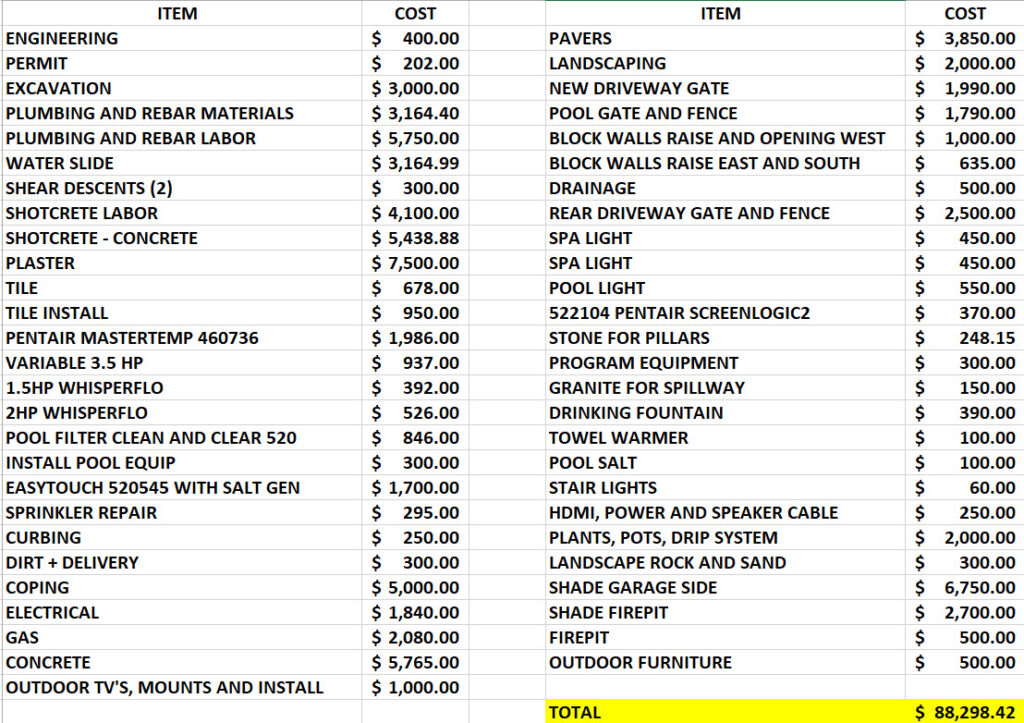
Please note that most figures above are from early 2019 and wherever possible, I shopped around extensively, pieced together systems with relatively inexpensive open-box E-bay purchases and did labor and installation myself to cut down on costs which could make prices appear artificially low even for 2019. To give an idea of how badly things have changed you can pick any item and compare current costs. Pentair Mastertemp 400,000 btu heater which I bought for under 2K is now $3,300-$4,300 online. The water slide I bought for about $3K, is now $4,300-$5,000 online. I believe I paid about $3.50 per sqft of concrete back then. Last quote I got for flatwork more recently was over $8 per sqft. I assume everything else has experienced a similar level of inflation.



